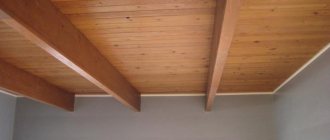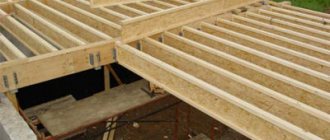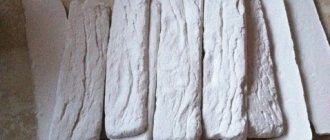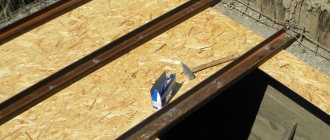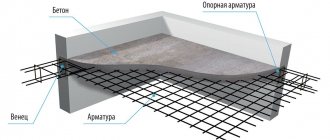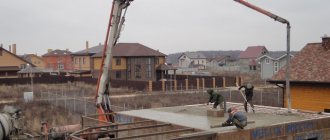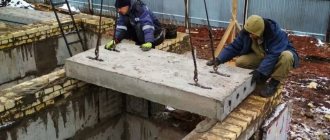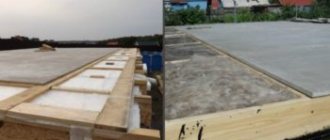If you are completing a house, almost the finishing work has already been done and you don’t know whether to take on the attic or whether this matter can wait, and in general what is needed at this stage - this article will help you. Here we will look at insulating attic floors with different types of materials, with step-by-step illustrations, expert advice and useful videos.
We will also reveal many important points about why insulation is so necessary and what an attic floor pie on wooden beams and on a reinforced concrete slab should actually be like - step by step.
What insulation is suitable for the attic?
The attic floor needs to be insulated when the attic space is not planned to be used for housing. Those. we are talking about a cold attic, the roof slopes of which are not insulated at all. But not all the same materials are suitable for covering, so they are selected for slopes.
Mineral wool: no harmful dust
So, when insulating an attic floor with mineral wool, it is correct to use the so-called tension method. Its essence is that the insulating material is first laid - and so that it fits between the beams.
After this, three layers of slab or roll insulation made of mineral wool, with a total thickness of about 150 millimeters, are laid on it, and on top it is covered with a vapor barrier film. After this, it’s plywood, which should be no thinner than 18 millimeters.
Expanded polystyrene and polystyrene: ease of installation
The insulation of the attic floor using expanded polystyrene is also of high quality, the main advantage of which is that there is no need for vapor barrier, and all gaps are easily sealed with polyurethane foam.
Blown-in insulation: fashion and rationality
Recently, insulation of attic floors using the blow-in method has become especially popular.
The main advantage of blown-in insulation is that it automatically fills all the voids that exist and creates an even, continuous layer. In which there are no joints, no seams and no adjoining, and for which there is no need to cut separate small pieces of prickly insulation in order to plug something.
Today, to insulate cold attics in Russia, two types of blown-in insulation are mainly used: ecowool and blown-in wool.
Ecowool consists of up to 80% cellulose fibers, which are produced from ordinary waste paper, and 20% from additives such as Buran as a fire retardant and boric acid as an antiseptic. This insulation has high thermal conductivity.
But blown-in cotton wool is obtained by grinding ordinary mineral materials for thermal insulation, which for some reason did not pass product acceptance.
For example, they did not have sufficient density or correct fiber structure. And such material is crushed and packaged under high pressure, and therefore it is easy to transport it to the site, where everything will be loosened again upon arrival.
But still, ecowool is most often used as a material. The insulation process itself looks like this: one person must remain next to the installation and monitor its normal operation, while simultaneously loading the material. And the second person goes up to the attic with a hose, makes a cross-shaped cut on the vapor barrier (just between the beams), inserts the hose into this cut, and fills the cavity with material.
Plus, relatively inexpensive bulk materials are used to insulate a cold attic:
Insulation layers
So, if you imagine a cross-section of the interfloor insulation cake, it will consist of the following layers:
- upper floor flooring boards;
- logs;
- floor vapor barrier;
- beams with a layer of heat and sound insulation laid between them;
- ceiling vapor barrier;
- ceiling cladding.
In multi-storey buildings, insulation of the interfloor floor is relevant only if this floor is made between the basement and the first floor, as well as in the case of the floor between the upper floor and an unheated attic.
If the ceiling separates two residential heated floors, then the role of insulating material for insulation is negligible. In this case, the soundproofing properties of the structure are much more important. Despite the fact that heat and sound insulating materials are included in the same group when classified according to purpose and technological characteristics, their properties may be different.
These differences must be taken into account when using this or that material in a specific interfloor covering.
What insulation parameters should you pay attention to?
We in no way encourage you to purchase the most expensive thermal insulation materials to insulate your attic floor. But note that the more and longer any well-known company produces materials for this purpose, the more it pays attention to quality, changing their volumetric weight, improving their products and increasing thermal insulation coefficients. And this already says something.
Otherwise, always pay attention to the parameters of insulation that are important for a wooden floor, and have no significance for a concrete floor - and vice versa.
Parameter No. 1. Biostability
The point is to ensure that such insulation, which often remains open, does not harbor bugs or other living creatures. This is especially true for mice, which love to live in a warm and dry (and, most importantly, deserted) attic.
Another important requirement for attic insulation is water resistance. Raindrops or simply moisture that accidentally fall into it should not lead to the process of rotting.
Glass wool is recognized as one of the most durable insulation materials:
Parameter No. 2. Thermal conductivity
The main requirements for attic insulation are the ability to maintain thermal insulation properties for a long time.
When purchasing insulation, also pay attention to this interesting point: modern manufacturers of thermal insulation materials always indicate in the technical specifications three coefficients of thermal conductivity of the material: in a dry state, at temperatures of 10° and 25°, and humidity categories A and B.
You need to look at the thermal conductivity coefficient in a dry state, or at a temperature of 10 degrees, because this is the normal climate in the attic. For a more accurate and detailed thermal calculation, you will need a SNiP table.
Now let's note this point. When choosing when purchasing insulation, you will probably be advised to take insulation with the lowest possible degree of thermal conductivity. But in fact, this only makes sense for residential attics, because when you have to insulate roof slopes, you cannot lay too thick materials between the rafters. Therefore, here we need materials that will conduct heat as poorly as possible, but at the same time have a small thickness.
But for the attic floor, the thickness of the insulation is not a critical factor, and you can save on this. Just take cheaper insulation, but thicker, albeit with high thermal conductivity. Everything is compensated by the height of the insulation itself.
Parameter No. 3. Weight
Depending on the chemical composition, each insulation has its own volumetric mass. Thus, materials such as basalt, glass and any other inorganic and organic compounds are most often used as a basis for fibers. Depending on their type, the heat-insulating material itself becomes either light or heavy. And the shape of all these materials is ensured precisely by the elasticity of the fibers: how they straighten between the floor beams.
Note that heavy insulation materials hold their shape better due to the rigidity of their fibers. And the best stability for insulating attic floors is provided by foam insulation, which in this parameter is equivalent to hard stone wool. But there is a point: the same mineral wool insulation that was inserted between the floor beams can easily straighten out and press tightly against the wood, but foam insulation will not do this, and voids are formed - the bridges are cold. Therefore, you will have to additionally use a can of foam to close all the cracks.
But if you insulate the attic floor on a reinforced concrete slab with foam-based materials, then there will only be advantages. Not to mention the fact that the concrete floor of the attic itself already has considerable weight and creates a serious load on the walls and foundation of the house, and using lightweight insulation for it is just a big bonus.
And unlike a concrete floor, an attic floor can withstand a fairly limited load. Therefore, the weight of the insulation in this regard is also not the last point. After all, there are already many variations here: the same cubic meter of thermal insulation can weigh either 11 kilograms or all 350 - this is the norm.
One of the heaviest insulation materials is basalt wool:
Parameter No. 4. Moisture resistance
Rain moisture that accidentally gets into the insulation or roof leaks should not start the rotting process. It’s bad if after just six months or a year the new insulation begins to decompose from the inside, emitting an unpleasant smell of dampness.
Therefore, insulation of attic floors over wooden beams and concrete is quite often done using polystyrene foam or expanded polystyrene, which are known for their almost zero hydrophobicity.
Parameter No. 5. Environmental friendliness
One more point: the attic insulation should not emit any toxic or pungent odor substances, despite the fact that, perhaps, no one will walk in such an attic.
It's all about ventilation: sooner or later, insulation molecules are picked up by the air and carried into living spaces, which can be unsafe for the residents of the house. Therefore, choose insulation that meets sanitary standards.
Parameter No. 6. Saving the form
Another important point is the form stability of the selected insulation. Thus, special laboratory tests have shown that over time, heat loss through the cracks between the slabs or matte insulation can reach 40%. And this despite the fact that the material itself during the same time may not change its thermal conductivity coefficient at all, if it remains dry.
Therefore, the stability of the shape and size of the material over time is very important. For a concrete attic floor, such gaps will not be critical, because here the floor itself is quite heat-insulating, which cannot be said about the attic floor.
But the problem is that such a parameter as shape or stability cannot be found in the technical information for modern thermal insulators.
Parameter No. 7. Fire safety
And the last point: attic insulation must meet all fire safety requirements. Take the same popular ecowool, which is made not just from ordinary waste paper and pieces of newspapers. It would seem that everything is simple and ingenious, why don’t you also cut the paper smaller and just fill the attic with it? Would it be worse? After all, the principle of looseness is also involved here, like in animal fur, when air molecules get stuck between small elements.
Let's put it this way: yes, the insulating properties of this method will be no worse, but it is old dry paper and wood that most often leads to unexpected fires. That is why modern cellulose insulation is necessarily treated with special chemicals to prevent fire.
If we are talking about the flammability of materials, then it is important that the insulation not only does not burn, but also has attenuation. Just remember that at the epicenter of the fire everything burns, both iron and concrete, but if a spark falls on the attic floor, the insulation should not catch fire. That's what we're talking about.
This is what the attic insulation cake itself should look like:
Calculator
| Calculation examples |
Related calculators:
- Collection of loads on floor beams online.
- Calculation of a rectangular pipe
- Square pipe calculation
- I-beam calculation
- Channel calculation
- Angle calculation
Vapor barrier issues: how, on which side and is it necessary?
For insulation of wood and concrete roofing, the vapor permeability of the insulation is of great importance. Thus, all insulation materials that are manufactured today in the form of slabs and rolls can be divided into “cotton wool” and “foam,” as construction contractors like to do.
We include thermal insulation materials made of organic and mineral fibers as “cotton” materials - these are mineral wool, stone wool and glass wool insulation. All these materials are formed by the hardening of plastic masses of various chemical origins. And all these materials have approximately the same thermal conductivity coefficient: within 0.04.
All these materials consist of fibers that are intertwined. They do not form any closed pores, and water vapor easily penetrates and escapes through them. Therefore, all cotton insulation materials are vapor-permeable materials. Why, during production, their fibers are additionally coated with a special water-repellent substance, and the insulation also turns out to be hydrophobized: the water molecule from water vapor is not allowed to penetrate inside and wet the insulation. It can only cling to its surface, and when a critical mass accumulates, it transforms into drops and rolls down. It turns out that hydrophobized cotton insulation is not a wet, vapor-permeable material.
Therefore, until now, scientists from all over the world cannot come to an unambiguous conclusion: the vapor permeability of building insulation is good or bad. Let's just say that if you are installing an attic floor on wooden beams, you better lay vapor-permeable materials on it so that the wooden rafters, which take on moisture from the lower living spaces (and water vapor always rises upward), can easily transfer it to the insulation . And they will easily come out of the insulation - just through ventilation is enough. But in terms of insulation of concrete floors, there is not much difference. But there is a point here: when using vapor-permeable insulation, it is important that the ventilation of such an attic is organized according to all the rules, and a separate ventilation system would not hurt.
Note that there are no fibers in foam insulation, since such material is literally produced from thin air. All foam insulation consists of a cellular structure, with closed bubbles and not closed ones, like a kitchen sponge. Therefore, such heat insulators can be either vapor-permeable or non-vapor-permeable. For example, extruded polystyrene foam, which is better known to us as polystyrene foam, allows water vapor to pass between the balls, but extruded polystyrene foam does not.
What’s interesting is that you can use not only one type of insulation, but two at once to compensate for each other’s shortcomings. But at the same time, thermal insulation material with lower vapor permeability must necessarily lie in front of insulation with high vapor permeability. That is, first polystyrene foam, then cotton wool. Otherwise, in the opposite case, a material with less vapor permeability will become a certain vapor barrier for another material, which will simply begin to rot and the moisture will have nowhere to escape.
Design nuances
The ceiling, made on beams, consists of wooden beams that are laid at a certain distance from each other. They determine the degree of strength and reliability of the entire structure. Usually they are sheathed (on one side or both) with various materials of a flat configuration. These can be sheets, panels or slats. Inside a structure equipped with this method, voids appear between the beams, inside of which it is convenient to lay insulation.
Another feature is the presence of wooden beams, which are fragments of lumber. Attaching additional elements to a wooden structure is very simple. The fastening elements can be self-tapping screws or nails; there is no need to glue or embed the heat insulator. Thus, the process of installing insulated floors becomes as simple and convenient as possible.
How to insulate a concrete attic floor
If we are talking about insulating an attic floor made of concrete, then the thermal insulation must necessarily be in the form of two or three layers with overlapping joints of each lower layer. Moreover, it is very important that the entire surface is leveled so that there are no irregularities of more than 5 millimeters anywhere - this is not difficult to achieve with the help of modern leveling mixtures.
For concrete attic floors, extruded polystyrene foam slabs are ideal for thermal insulation. They don’t need a vapor barrier, but if you’re putting in polystyrene foam, it’s not extruded polystyrene foam, and then, of course, it’s needed.
Additionally, if you then need to walk on such a floor, you can make a cement-sand screed up to 4 centimeters and lay two layers of plasterboard sheets. Just be sure to make paths from masonry mesh for such a screed along which you will walk. Be sure to seal the joints between the polystyrene foam boards with tape so that cement laitance does not leak between the boards.
The attic floor itself can be insulated both at the manufacturing stage and at almost any time during the operation of the house itself. Of course, for the attic it is much more correct to insulate the ceiling before you move into your new home.
More details about the process itself:
When to insulate the ceiling
According to the laws of physics, warm air always rises to the top. If the attic space is not heated, heat from the lower floor goes out through it. Heat loss can be up to 40%. Warm air escapes through small cracks in concrete and pores in wooden ceilings. Properly performed thermal insulation will prevent freezing and reduce heating costs.
In all private houses with a cold ceiling, it is recommended to thermally insulate the ceiling. Such work can be performed at the construction stage or in an already constructed house. In the second case, insulation is carried out if the coatings were made a long time ago and over time have lost their heat-insulating properties.
How to insulate a wooden attic floor
So, there are two main ways to insulate an attic floor: laying a heat-insulating layer inside the attic floor structure, and laying insulation on top of it. For a cold and uninhabited attic, it is not necessary to cover the insulation with something on top and build a full floor. But then be sure to leave walking ladders - separate paths made of sparse flooring throughout the entire area of the attic, this is necessary for roof maintenance.
A vapor barrier must be placed under the insulation, in the form of a trough, so that it can protect the insulation from water vapor that comes from the lower living quarters. But there is an exception to this rule: if the insulation was laid with good resistance, for example, it is foam or extruded polystyrene foam, then a vapor barrier is not needed here. But if we are talking about an attic with a particularly humid regime, for example, above a kitchen or sauna, then a serious vapor barrier layer needs to be installed here.
Another method is tension, when the vapor barrier only sags slightly between the beams. The disadvantage of this method is that the insulation between the beams is not inserted tightly enough.
And if the ceiling is also made from ready-made companies, then this option is not suitable at all, because such voids quickly become so-called cold bridges. Therefore, in Russia, the more popular method is in which the insulation is first laid, then a vapor barrier is covered, and only then with the finishing flooring.
So, here's what the whole insulation process looks like:
- Step 1. A vapor barrier is secured between the beams using a construction stapler.
- Step 2. Next, mineral wool slabs are cut so that their width corresponds to the pitch of the beams.
- Step 3. These slabs are carefully inserted into the gap between the beams.
- Step 4. While the ceiling below is not yet ready, so that the insulation does not fall between the beams, it is supported by rough bars or a strong thread stretched specially for this purpose.
- Step 5. Next, a diffuse membrane is quickly installed on top of the insulation - so that steam can easily escape through it, and drops from above from the slopes do not penetrate inside.
But let us also note the following point about the last step. Many experts believe that no diffuse membranes or windproof films are needed for insulation, because in a cold attic the insulation will dry due to natural ventilation of convection air flows, which easily penetrate through openings and dormer windows.
Material selection criteria
The wooden frame of a private house has its own requirements for choosing a thermal insulation solution:
- coefficient of thermal conductivity. The indicator is important to ensure the required level of resistance to thermal energy losses;
- vapor permeability level. For example, to preserve the performance properties of mineral wool, protection with a vapor barrier membrane is necessary, since fibrous insulation absorbs moisture from the air;
- moisture resistance coefficient;
- flammability class;
- environmental friendliness;
- frost resistance;
- resistance to microbiological threats;
- level of attractiveness to rodents and insects;
- ease and convenience of installation.
Availability of material is also considered an important criterion. One of the most popular insulation materials in private housing construction is basalt wool. The solution provides extremely low thermal conductivity parameters, environmental friendliness, a high level of resistance to moisture and steam, is sold in a relatively affordable segment, and is suitable for self-installation.
